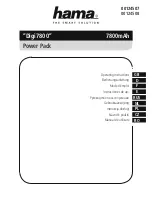
© EA Elektro-Automatik in 2022, this information is subject to change without notice
82
06230820_manual_psi_10000_3u_15kw_en_01
3.10.15
Extended PV function according to EN 50530
3.10.15.1 Introduction
This extended PV table function according to standard EN 50530 is used to simulate solar panels in order to test and rate
solar inverters. It offers manual configuration and control, as well as remote control. It’s also based on the XY generator, same
as the simple PV table function from
, but allows for more specific tests and evaluations due to further adjustable
parameters, which are explained below. The impact of the parameters on the PV curve and the simulation is described in the
standard paper of EN 50530, which user can refer to in case more detailed description is required. This section only deals
about configuration and control of the PV simulation.
3.10.15.2
Differences to the basic PV function
The extended PV function has five additional or different characteristics compared to the simple PV function:
•
The simulation distinguishes between a single test run and an automatic test run, called day trend, which is based upon a
user-defined curve built from up to 100,000 points
•
There are two invariable and one variable panel technology available to choose from
•
There are more parameters available to adjust during runtime
•
It allows for data recording during runtime and to save the data either to USB stick or read via digital interface
•
It allows to select between two different parameter sets to adjust during runtime
3.10.15.3 Technologies and technology parameters
When configuring the PV simulation it’s required to select the solar panel technology to simulate. The technologies
cSI
and
Thin film
are invariable in their parameters, while technology
Manual
is variable in all parameters, but within specific limits.
This allows for the variation of the simulation and when copying the fixed parameter values from
cSi
or
Thin film
to
Manual
,
it even enables their variation as well.
One advantage of the invariable technologies is that their technology parameters are automatically set to their defined defaults
in the configuration procedure.
Overview of the technology parameters used in the PV curve calculation and their defaults:
Abbr.
Name
Manual
cSI
Thin film
Unit
FFu
Fill factor for voltage
>0...1 (0.8)
0.8
0.72
-
FFi
Fill factor for current
>0...1 (0.9)
0.9
0.8
-
Cu
Scaling factor for U
OC
(1
>0...1 (0.08593)
0.08593
0.08419
-
Cr
Scaling factor for U
OC
(1
>0...1 (0.000109)
0.000109
0.0001476
m²/W
Cg
Scaling factor for U
OC
(1
>0...1 (0.002514)
0.002514
0.001252
W/m²
alpha
Temperature coefficient for I
SC
(2
>0...1 (0.0004)
0.0004
0.0002
1/°C
beta
Temperature coefficient for U
OC
(1
-1...<0 (-0.004)
-0.004
-0.002
1/°C
(1 Uoc = Open circuit voltage of a solar panel
(2 Isc = Short-circuit current (=max. current) of a solar panel
3.10.15.4 Simulation mode
Apart from the panel technology there is also a simulation mode to select. Four options:
U/I
Controllable simulation. Voltage (U
MPP
, in V) and current (I
MPP
, in A) in the maximum power point (MPP)
are variable during runtime. The purpose of this mode is to directly shift the MPP into various directions.
E/T
Controllable simulation. During runtime, the irradiation (E from german “Einstrahlung”, in W/m²) and sur
-
face temperature (T, in °C) of the simulated solar panel are adjustable. This also impacts the curve and
the resulting MPP. The purpose of this mode is to analyze the impact of temperature and/or irradiation
on the performance of a solar panel.
DAY U/I
Automatic simulation run, processing a day trend curve consisting of up to 100,000 points defined by
values for U
MPP
, I
MPP
and time.
DAY E/T
Automatic simulation run, processing a day trend curve consisting of up to 100,000 points defined by
values for irradiation, temperature and time.















































